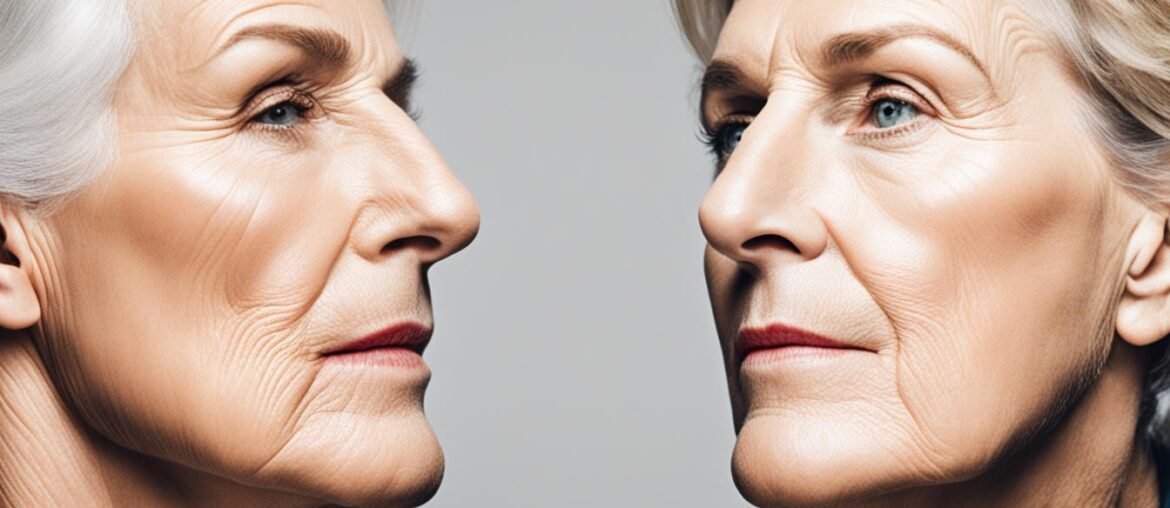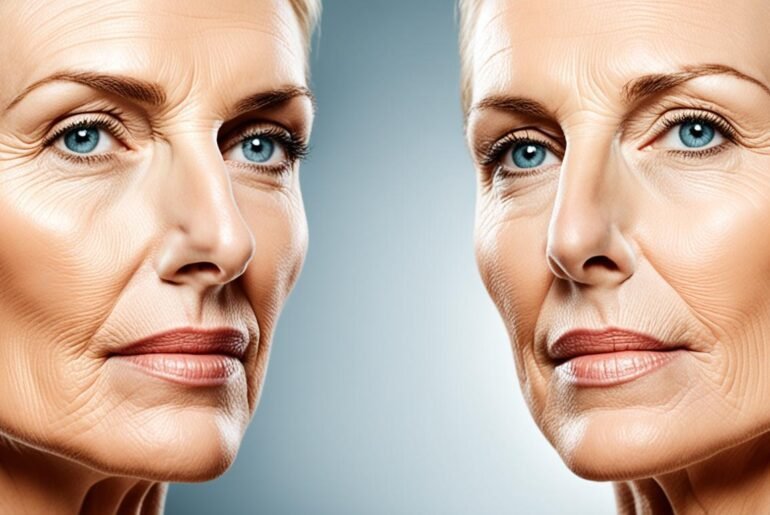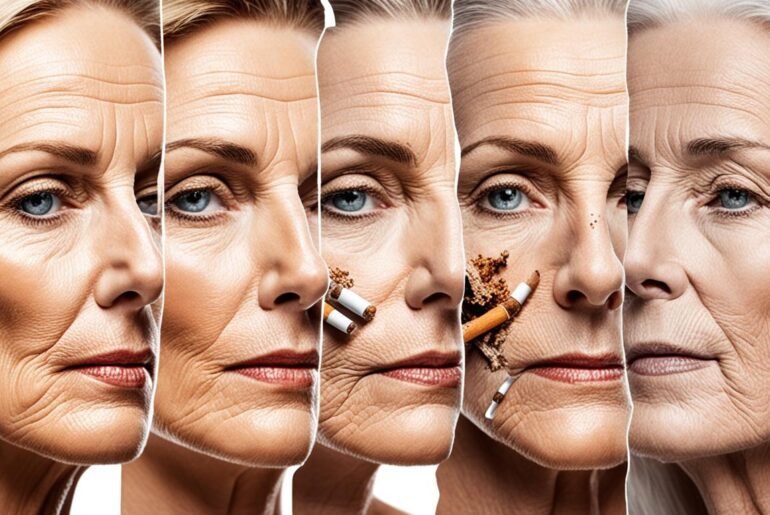Did you know that smoking is responsible for more than three million deaths worldwide? Not only does smoking have detrimental effects on our overall health, but it also significantly impacts our skin. Epidemiological studies have shown that smoking is a major environmental factor in premature skin aging, causing wrinkles, sagging, discoloration, and overall damage to the skin.
Key Takeaways:
- Smoking is a major contributor to premature skin aging, leading to wrinkles, sagging, and skin discoloration.
- Tobacco smoke extract impairs collagen production and disrupts dermal connective tissue metabolism.
- Smokers have reduced blood supply to the skin, resulting in decreased oxygen delivery and impaired wound healing.
- Quitting smoking is crucial for maintaining a youthful appearance and protecting the health of the skin.
- Various treatments and resources are available to support individuals in their journey towards a smoke-free life.
The Impact on Collagen and Elasticity
Smoking has a significant impact on collagen production in the skin. It increases the production of enzymes that break down collagen, leading to reduced skin elasticity and the formation of wrinkles. Smokers often exhibit characteristic patterns of wrinkling, including lines around the mouth and “crow’s feet” around the eyes. The motion of sucking on a cigarette and the direct heat of the cigarette may contribute to these wrinkles. Additionally, smoking causes blood vessels to constrict, reducing blood supply to the skin, which further contributes to loss of elasticity and premature aging.
Effect of Smoking on Collagen Production
Collagen is a crucial protein that provides structure and strength to the skin. Smoking disrupts the delicate balance of collagen synthesis and degradation, favoring collagen degradation. This process is driven by the increased production of enzymes that break down collagen, such as matrix metalloproteinases (MMPs), while inhibiting the production of collagen itself. As a result, the skin loses its firmness, elasticity, and ability to bounce back, leading to the formation of wrinkles.
Characteristic Wrinkling Patterns in Smokers
Smokers often develop distinct patterns of wrinkling due to the repetitive motion of sucking on a cigarette and the direct heat of the cigarette. These movements primarily affect the areas surrounding the mouth and the skin around the eyes. Wrinkles around the mouth, often referred to as “smoker’s lines,” are caused by the pursing motion of the lips while smoking. The heat from the cigarette can also contribute to the development of fine lines and “crow’s feet” at the corners of the eyes.
Impact of Reduced Blood Supply
Smoking causes blood vessels to constrict, reducing blood supply to the skin. This decreased blood flow deprives the skin of necessary oxygen and nutrients, hindering its ability to repair and regenerate. Collagen synthesis requires optimal blood supply to deliver the necessary building blocks for collagen production. With reduced blood flow, the skin’s capacity to rebuild and maintain collagen is compromised, leading to a decline in skin elasticity and an increased likelihood of wrinkles.
Premature Aging and Accelerated Wrinkling
The combined effects of collagen degradation, reduced elasticity, and impaired blood supply contribute to premature aging in smokers. Smoking accelerates the natural aging process of the skin, making it appear aged, sagging, and wrinkled at a younger age compared to non-smokers. The negative impact on collagen production and skin elasticity, coupled with the direct heat and repetitive motions associated with smoking, intensify the development of wrinkles and contribute to a prematurely aged appearance.
| Effect | Explanation |
|---|---|
| Increased collagen degradation | Smoking increases the production of enzymes that break down collagen, leading to its degradation and reduced skin elasticity. |
| Constricted blood vessels | Smoking causes blood vessels to constrict, reducing blood supply to the skin and impairing collagen production. |
| Repetitive motion and direct heat | The motion of sucking on a cigarette and the direct heat from the cigarette contribute to the development of characteristic wrinkles. |
| Accelerated aging process | Combining collagen degradation, reduced elasticity, and impaired blood supply accelerate the aging process, causing premature wrinkling. |
“Smoker’s Face” – Aesthetic Changes
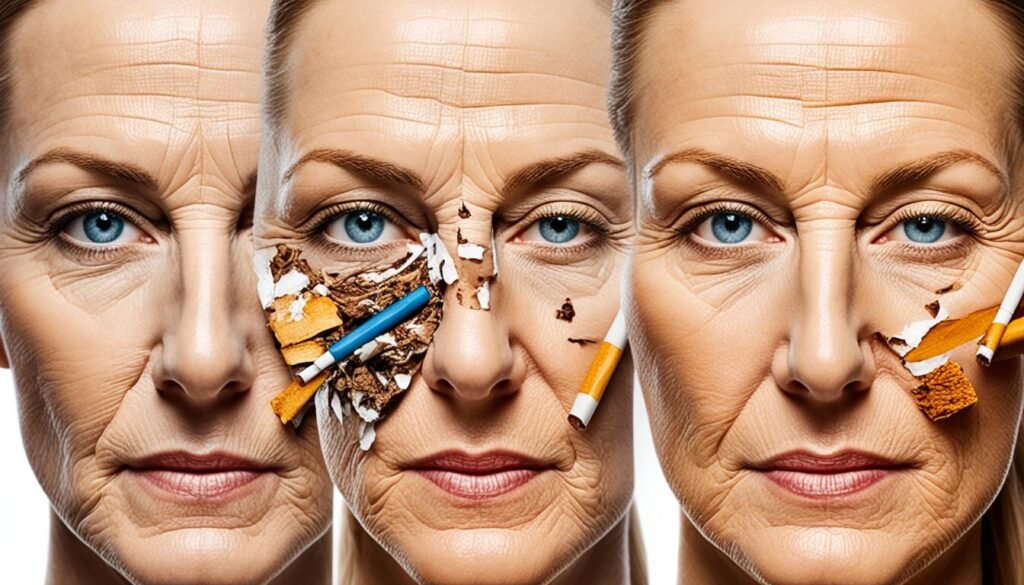
Smoking can have detrimental effects on the appearance of the face, causing various aesthetic changes commonly referred to as “smoker’s face.” These changes include skin discoloration, a dull and washed-out appearance, and overall skin damage.
The vasoconstrictive effect of smoking reduces blood supply to the skin, leading to a lack of oxygen and nutrients. This deprivation of vital elements contributes to skin discoloration, resulting in an uneven complexion and a less vibrant appearance.
Additionally, the release of smoke into the air during smoking can directly interact with the skin, drying it out and further exacerbating the damage. The combination of reduced blood supply and the direct impact of smoke contributes to the distinct appearance associated with smokers.
Smoker’s face is often characterized by a dull and tired-looking complexion, with an overall lack of radiance. The damaging effects of smoking on the skin can lead to premature aging, making smokers appear older than their actual age.
Quitting smoking is crucial for improving the overall health and appearance of the skin. By eliminating tobacco smoke exposure, the skin has an opportunity to repair and rejuvenate, restoring a more youthful and vibrant complexion.
| Effects of Smoking on the Skin | Description |
|---|---|
| Skin Discoloration | Smoking reduces blood supply to the skin, leading to a lack of oxygen and nutrients, resulting in uneven skin tone and discoloration. |
| Dull and Washed-Out Appearance | The vasoconstrictive effect of smoking contributes to a dull and tired-looking complexion with reduced radiance. |
| Overall Skin Damage | Direct exposure to smoke can dry out the skin and cause damage, exacerbating the negative effects of smoking. |
Impaired Wound Healing
https://www.youtube.com/watch?v=qLzij34r3lY
Smoking has detrimental effects on wound healing, significantly delaying the recovery process for injuries and surgical wounds. As a result, smokers are at a higher risk of developing infections in these wounds and experiencing complications such as the failure of skin grafts or flaps.
The impaired wound healing observed in smokers can be attributed to several factors. One key factor is the reduced blood supply to the skin caused by smoking. This reduced blood flow leads to a decrease in oxygen delivery to the wound site, hindering the healing process. Additionally, the growth of new blood vessels, which is crucial for proper wound healing, is slowed down in smokers.
Smoking also affects collagen production, further compromising wound healing. Collagen plays a vital role in the formation of new tissue and the closure of wounds. However, smokers have decreased collagen production, which impairs the body’s ability to rebuild and repair damaged skin.
The combination of reduced blood supply, impaired oxygen delivery, and decreased collagen production creates an unfavorable environment for wound healing in smokers. It is essential to note that these effects are not limited to small wounds or superficial injuries; they can also impact more significant surgical procedures.
Quotes:
“Smoking delays the healing process and increases the risk of complications in wounds, impairing the body’s natural ability to repair and rebuild damaged skin.” – Dr. Jessica Carter, Dermatologist
Impaired Wound Healing in Smokers
| Effect | Description |
|---|---|
| Infections | Smokers are at a higher risk of developing infections in wounds. |
| Skin Graft/Flap Failure | Smokers have a higher likelihood of experiencing failures in these surgical procedures. |
| Blood Clots | Smokers have an increased risk of blood clot formation, which can impede the healing process. |
Increased Risk of Psoriasis
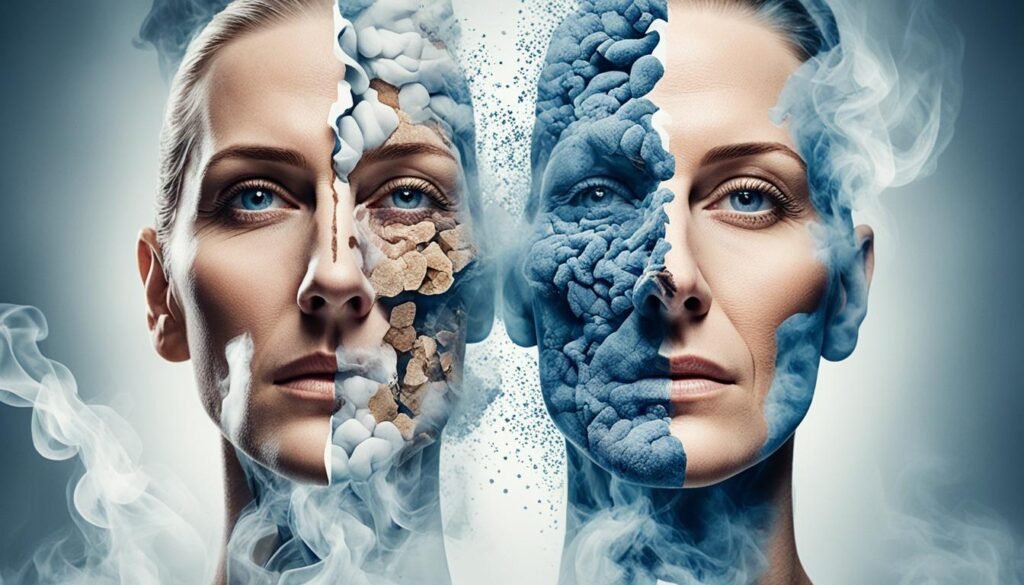
Smokers are two to three times more likely to suffer from psoriasis, an inflammatory skin condition. Psoriasis can cause discomfort and negatively impact one’s appearance. The exact mechanisms linking smoking and psoriasis are not fully understood, but the effects of tobacco on skin aging and immune system function may be involved. The risk of psoriasis is dependent on the amount of smoking, with a higher risk associated with increased smoking.
| Effects of Smoking on Psoriasis | Risk Factors |
|---|---|
| Increased likelihood of developing psoriasis | Higher amount of smoking |
| Exacerbation of existing psoriasis symptoms | Long-term smoking habit |
| Impact on immune system function | Frequent exposure to secondhand smoke |
Psoriasis is characterized by red, itchy patches of skin covered with silvery scales. It can appear anywhere on the body, including the scalp, elbows, knees, and lower back. Smokers with psoriasis often experience more severe symptoms and a reduced response to treatment compared to non-smokers. Quitting smoking can help reduce the severity and progression of psoriasis, improving overall skin health and quality of life.
Premature Aging and Wrinkling
Smokers experience premature aging of the skin, characterized by the development of wrinkles and other signs associated with older age. Middle-aged smokers often display the same amount of wrinkles as non-smokers who are much older. Smoking accelerates the aging process of the skin, making it appear aged, sagging, and wrinkled. The harmful effects of smoking on collagen, elasticity, and blood supply contribute to this premature aging.
The nicotine and chemicals found in cigarettes have a detrimental impact on the skin, leading to the development of wrinkles and fine lines. Smoking restricts blood flow to the skin, depriving it of essential nutrients and oxygen. This reduction in blood supply impairs the skin’s ability to produce collagen, a protein responsible for its firmness and elasticity.
Furthermore, smoking promotes the breakdown of collagen and elastin fibers, which contribute to the skin’s structure and flexibility. As a result, the skin becomes less resilient and more prone to wrinkles and sagging. The repetitive facial movements associated with smoking, such as pursing the lips and squinting the eyes, also contribute to the formation of wrinkles in these specific areas.
Studies have shown that smokers are three times more likely to develop wrinkles earlier than non-smokers. The severity of wrinkles is also greater in smokers, with deeper lines and furrows appearing at an accelerated rate. These visible signs of premature aging can have a significant impact on a person’s self-esteem and overall appearance.
Quitting smoking is crucial to mitigate the effects of premature skin aging. By quitting, individuals give their skin a chance to heal and rejuvenate. Over time, the appearance of wrinkles can improve, and skin elasticity can be restored to some extent.
The Effects of Smoking on Premature Skin Aging:
| Effects | Description |
|---|---|
| Accelerated Wrinkling | Smokers experience the development of wrinkles at a faster rate compared to non-smokers. |
| Sagging Skin | Smoking contributes to the loss of skin elasticity, resulting in sagging and drooping skin. |
| Poor Collagen Production | Smoking impairs the skin’s ability to produce collagen, leading to reduced skin firmness and elasticity. |
| Impaired Blood Circulation | Smoking restricts blood flow to the skin, depriving it of vital nutrients and oxygen. |
| Increased Fine Lines | Repeated facial movements associated with smoking contribute to the formation of fine lines. |
Skin Discoloration and Dullness
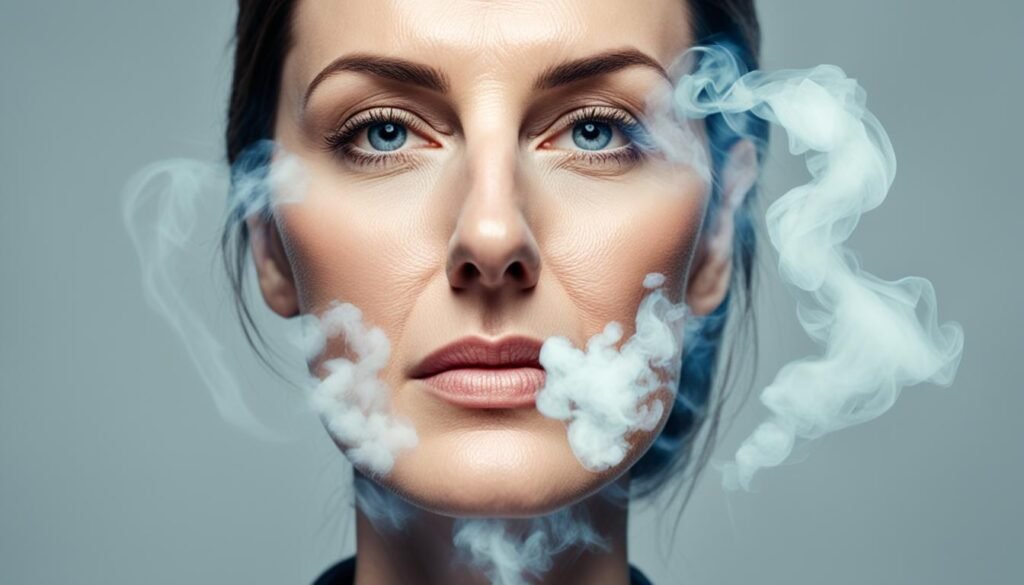
Smoking can have detrimental effects on the skin, including skin discoloration and a dull, washed-out appearance. The vasoconstrictive properties of smoking cause blood vessels to constrict, reducing blood supply to the skin. This reduction in blood flow leads to a lack of oxygen and nutrients, resulting in discoloration and damage to the skin.
Additionally, the direct interaction of smoke with the skin and potential burns from cigarettes can further contribute to skin discoloration. The combination of reduced blood supply, smoke exposure, and heat-related damage can leave the skin looking dull and lifeless.
It is important to note that the effects of smoking on the skin go beyond surface-level discoloration. The overall damage caused by smoking can lead to premature aging and increased risk of various skin conditions.
For a comprehensive understanding of the effects of smoking on the skin, refer to the table below:
| Effects of Smoking on the Skin | Description |
|---|---|
| Premature Aging | Smoking accelerates the aging process of the skin, leading to wrinkles, sagging, and loss of elasticity. |
| Collagen Degradation | Smoking impairs collagen production, resulting in reduced skin firmness and increased susceptibility to wrinkles. |
| Impaired Wound Healing | Smoking delays wound healing and increases the risk of infection, skin graft failure, and blood clots. |
| Increased Risk of Skin Conditions | Smoking is associated with an increased risk of skin conditions such as psoriasis and skin cancer. |
It is clear that smoking has profound effects on the skin, including discoloration, premature aging, and impaired healing. Quitting smoking is not only beneficial for overall health but also improves the appearance and vitality of the skin.
Negative Impact on Skin Elasticity
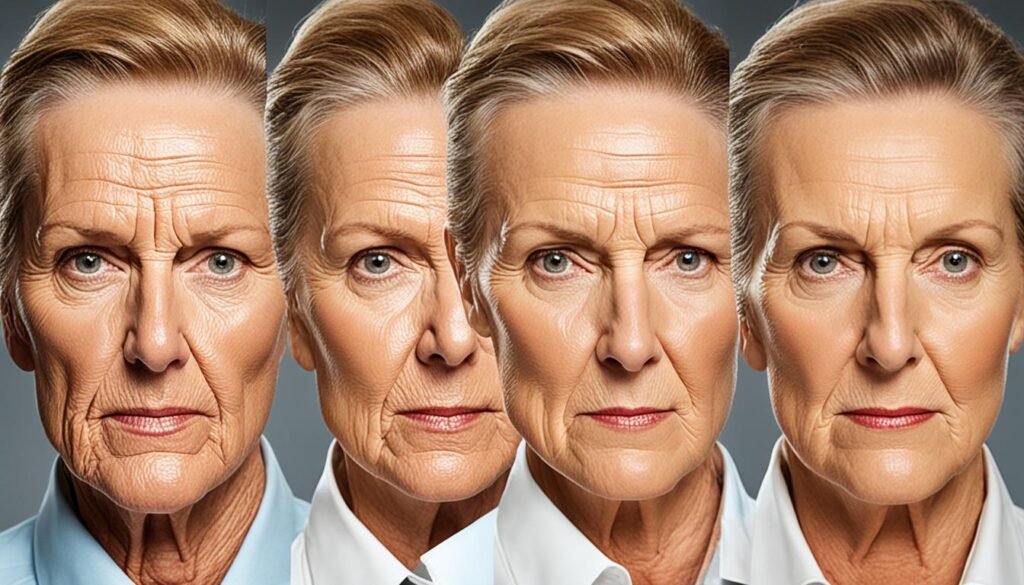
Smoking has a detrimental effect on skin elasticity, causing a loss of firmness and bounce-back ability. Collagen plays a crucial role in maintaining skin elasticity, but smoking disrupts its production and balance in the dermal connective tissue. This leads to collagen degradation and an imbalance between biosynthesis and degradation, resulting in decreased skin elasticity.
Collagen degradation occurs due to increased production of substances that degrade matrix proteins in the skin. As a result, the skin loses its ability to retain its firmness and elasticity, leading to sagging and wrinkles.
The negative impact of smoking on skin elasticity is one of the primary drivers of premature skin aging. The accelerated degradation of collagen caused by smoking contributes to the visible signs of aging, such as the formation of fine lines and wrinkles.
This image graphically represents the effect of smoking on skin elasticity, highlighting the damage caused by collagen degradation and impaired collagen production.
| Effects of Smoking on Skin Elasticity | |
|---|---|
| Promotes collagen degradation | Reduces skin elasticity |
| Disrupts collagen production and balance | Leads to sagging and wrinkles |
| Increases production of substances degrading matrix proteins | Impairs skin’s ability to bounce back |
This table provides an overview of the effects of smoking on skin elasticity, emphasizing the negative impact on collagen and its consequences for the skin’s firmness and bounce-back ability.
Effects on Wound Healing

Smoking has detrimental effects on wound healing, impairing the natural process and increasing the risk of complications. Smokers are more likely to experience infections in their wounds, as well as failure of skin grafts or flaps. Additionally, the risk of blood clots is heightened in smokers. These negative outcomes can be attributed to several factors.
The reduced blood supply to the skin caused by smoking limits the amount of oxygen and nutrients available for healing. This compromised blood flow hinders the formation of new blood vessels, slowing down the growth of vital tissue that aids in wound repair. The lack of oxygen delivery further deprives the wound of the necessary resources for optimal healing.
Furthermore, smoking disrupts collagen production, which plays a crucial role in wound healing. Collagen is a protein that helps provide structure and strength to the skin. The decreased production of collagen in smokers can lead to delayed wound closure and weaker scar tissue formation.
It is important to note that the negative effects of smoking on wound healing are not limited to surgical wounds. Even minor cuts or injuries can take longer to heal in smokers compared to non-smokers. It is crucial for individuals who smoke to be aware of these risks and consider smoking cessation to improve their overall wound healing
Why does smoking impair wound healing?
“Smoking reduces blood supply to the skin, limiting oxygen and nutrient delivery to the wound. It also disrupts collagen production, hindering the formation of new tissue. These factors contribute to impaired wound healing in smokers.”
Risk of Psoriasis

Smokers have an increased risk of developing psoriasis, an inflammatory skin condition. The exact mechanisms linking smoking and psoriasis are not fully understood, but the effects of smoking on skin aging and immune function are believed to contribute. Research has shown that smokers are two to three times more likely to suffer from psoriasis compared to non-smokers (source).
Psoriasis is a chronic autoimmune disease that affects the skin, causing red, scaly patches to appear. These patches can be itchy and painful, leading to discomfort and a negative impact on one’s appearance. While the exact relationship between smoking and psoriasis remains unclear, there are several theories on how smoking may increase the risk of developing this skin condition.
One theory suggests that smoking triggers inflammation in the body, which can affect the immune system and contribute to the development of psoriasis. The chemicals in cigarette smoke may disrupt the normal functioning of immune cells, leading to an abnormal immune response and the onset of psoriasis. Additionally, smoking has been shown to worsen existing psoriasis symptoms and increase the severity of flare-ups (source).
Furthermore, smoking has detrimental effects on skin health and can accelerate the aging process. The nicotine and other toxic substances in cigarette smoke can damage the skin’s collagen and elastin fibers, leading to premature aging, wrinkles, and a loss of elasticity. These changes in the skin’s structure may create an environment that is more prone to the development of psoriasis (source).
If you are a smoker and have psoriasis, quitting smoking can have numerous benefits for your skin and overall health. Quitting smoking may help reduce inflammation, improve immune system function, and slow down the progression of psoriasis. It is always recommended to seek medical advice and support when attempting to quit smoking to increase the chances of success.
| Effects of Smoking on Psoriasis | Impact |
|---|---|
| Increased risk of developing psoriasis | Two to three times higher compared to non-smokers |
| Worsening of existing psoriasis symptoms | Increased severity of flare-ups |
| Potential disruption of immune system functioning | Abnormal immune response triggering psoriasis |
| Damage to collagen and elastin fibers in the skin | Premature aging and increased vulnerability to psoriasis |
| Quitting smoking can help reduce inflammation and slow down psoriasis progression | Positive impact on skin health and overall well-being |
Conclusion
Smoking takes a toll on your skin, accelerating the aging process and causing a range of detrimental effects. Wrinkles, sagging, skin discoloration, and damage are just some of the visible signs of premature aging caused by smoking. Collagen degradation, reduced skin elasticity, impaired wound healing, and increased risk of psoriasis are among the specific ways smoking affects the skin.
To maintain a youthful appearance and protect the health of your skin, quitting smoking is crucial. By quitting, you can reverse or prevent further damage to your skin and enjoy the benefits of a smoke-free life. While quitting smoking may be challenging, there are plenty of treatments and resources available to support you in your journey towards a smoke-free lifestyle.
Take control of your skin’s health and well-being by saying no to smoking. Your skin will thank you for it. Start your path towards healthier skin by quitting smoking today.
FAQ
What are the effects of smoking on premature skin aging?
Smoking has been found to contribute to premature skin aging, leading to wrinkles, sagging, and overall damage to the skin.
How does smoking impact collagen and skin elasticity?
Smoking increases the production of enzymes that break down collagen, resulting in reduced skin elasticity and the formation of wrinkles.
Does smoking cause aesthetic changes in the face?
Yes, smoking can lead to skin discoloration, a dull and washed-out appearance, and overall skin damage, often referred to as “smoker’s face.”
Does smoking affect wound healing?
Yes, smoking impairs wound healing by delaying the process and increasing the risk of complications such as infections, graft or flap failure, and blood clots.
Is there a connection between smoking and psoriasis?
Yes, smokers have an increased risk of developing psoriasis, an inflammatory skin condition.
How does smoking contribute to premature aging and wrinkling?
Smoking accelerates the aging process of the skin, making it appear aged, sagging, and wrinkled. It can cause middle-aged smokers to have the same amount of wrinkles as non-smokers who are much older.
Does smoking cause skin discoloration and dullness?
Yes, smoking reduces blood supply to the skin, resulting in skin discoloration and a dull and washed-out appearance.
Can smoking negatively impact skin elasticity?
Yes, smoking impairs collagen production and degrades existing collagen, leading to a loss of skin elasticity.
How does smoking affect wound healing?
Smoking slows down the healing process of wounds, increasing the risk of infections, graft or flap failure, and blood clots.
Is there a relationship between smoking and psoriasis?
Yes, smokers have a higher risk of developing psoriasis, an inflammatory skin condition.
What are the overall effects of smoking on the skin?
Smoking contributes to premature skin aging, wrinkles, skin discoloration, and damage. It also impairs wound healing and increases the risk of psoriasis.

